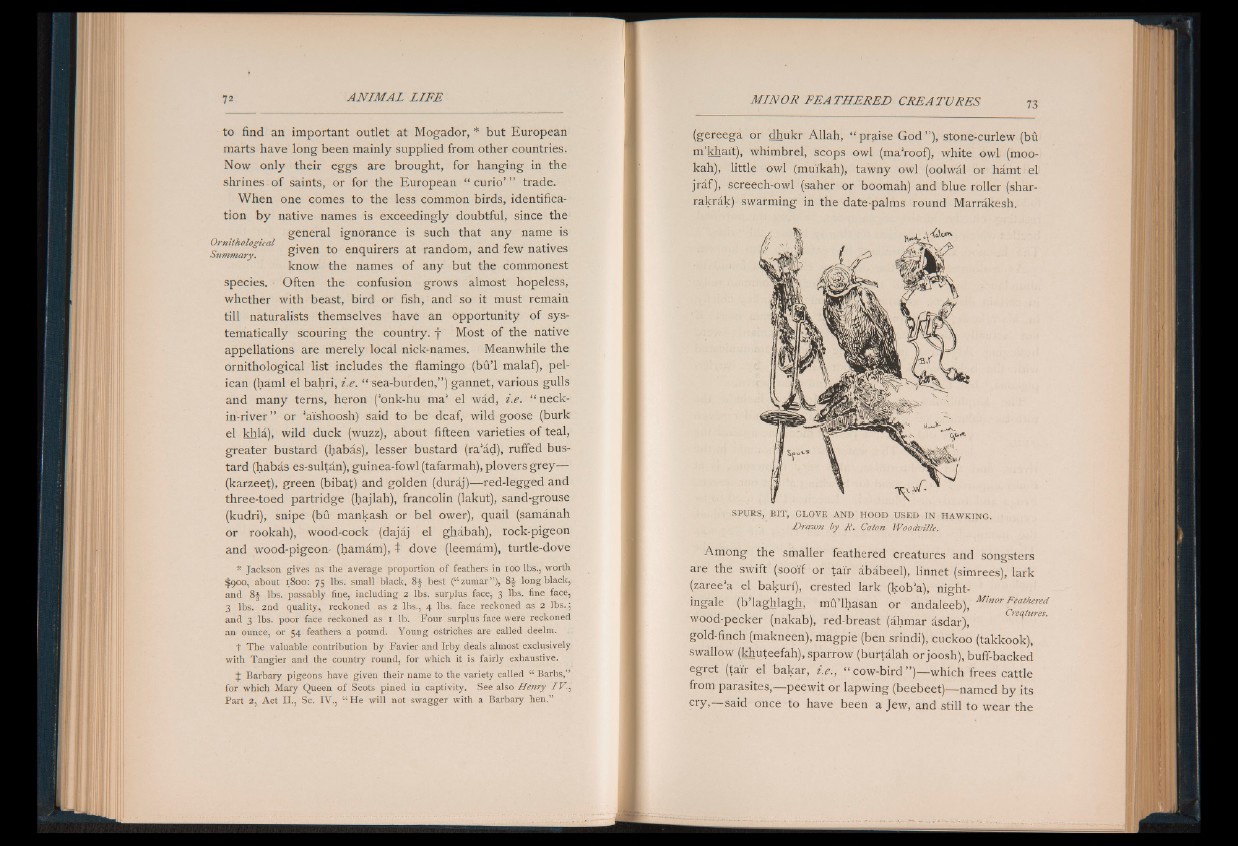
to find an important outlet at Mogador, * but European
marts have long been mainly supplied from other countries.
Now only their eggs are brought, for hanging in the
shrines of saints, or for the European “ curio” ’ trade.
When one comes to the less common birds, identification
by native names is exceedingly doubtful, since the
general ignorance is such • - 7 r • i ° o that any name is Ornithological . . . , 1 r , •
Summary given to enquirers at random, and tew natives
know the names of any but the commonest
species. Often the confusion grows almost hopeless,
whether with beast, bird or fish, and so it must remain
till naturalists themselves have an opportunity of systematically
scouring the country. •{• Most of the native
appellations are merely local nick-names. Meanwhile the
ornithological list includes the flamingo (bu’l malaf), pelican
(haml el bahri, i.e. “ 'sea-burden,” ) gannet, various gulls
and many terns, heron (‘onk-hu ma‘ el wád, i.e. “ neck-
in-river” or ’a'fshoosh) said to be deaf, wild goose (burk
el khlá). wild duck (wuzz), about fifteen varieties of teal,
greater bustard (habás), lesser bustard (ra'ád), ruffed bustard
(habás es-sultán), guinea-fowl (tafarmah), plovers g rey—
(karzeet), green (bibat) and golden (duráj)— red-legged and
three-toed partridge (hajlah), francolín (lakut), sand-grouse
(kudri), snipe (bu mankash or bel ower), quail (samánah
or rookah), wood-cock (dajáj el ghábah), rock-pigeon
and wood-pigeon- (hamám), t dove (leemám), turtle-dove
* Jackson gives as the average proportion of feathers io ioo lbs., worth
$900, about 1800: 75 lbs. small black, 8|- best (“ zumar”), 8j long black,
and 8| lbs. passably fine, including 2 lbs. surplus face, 3 lbs. fine face,
3 lbs. 2nd quality, reckoned as 2 lbs., 4 lbs. face reckoned as 2 lbs..;
and 3 lbs. poor face reckoned as 1 lb. Four surplus face were reckoned
an ounce, or 54 feathers a pound. Young ostriches are called deelm.
t The valuable contribution by Favier and Irby deals almost exclusively
with Tangier and the country round, for which it is fairly exhaustive.
+ Bafbary pigeons have given their name to the variety called “ Barbs,”
for which Mary Queen of Scots pined in captivity. See also Henry IV .,
Part 2, Act II., Sc. IV., “ He will not swagger with a Barbary hen.”
(gereega or dhukr Allah, “ praise G od ” ), stone-curlew (bu
m’khait), whimbrel, scops owl (ma’roof), white owl (moo-
kah), little owl (mui'kah), tawny owl (oolwal or hamt el
jraf), screech-owl (saher or boomah) and blue roller (shar-
rakrak) swarming in the date-palms round Marrakesh.
SPURS, BIT , GLOVE AND HOOD USED IN HAWKING.
Drawn by R. Caton Woodville.
Among the smaller feathered creatures and songsters
are the swift (sooi'f or tai'r ababeel), linnet (simrees), lark
(zaree'a el bakuri), crested lark (kob’a), nightingale
(b’laghlagh, mu’lhasan or andaleeb), MmorFeathered
wood-pecker (nakab), red-breast (ahmar asdar),
gold-finch (makneen), magpie (ben srindi), cuckoo (takkook),
swallow (khuteefah), sparrow (burtalah or joosh), buff-backed
egret (tai'r el bakar, i.e., “ cow-bird” )— which frees cattle
from parasites,— peewit or lapwing (beebeet)— named by its
cry,— said once to have been a Jew, and still to wear the